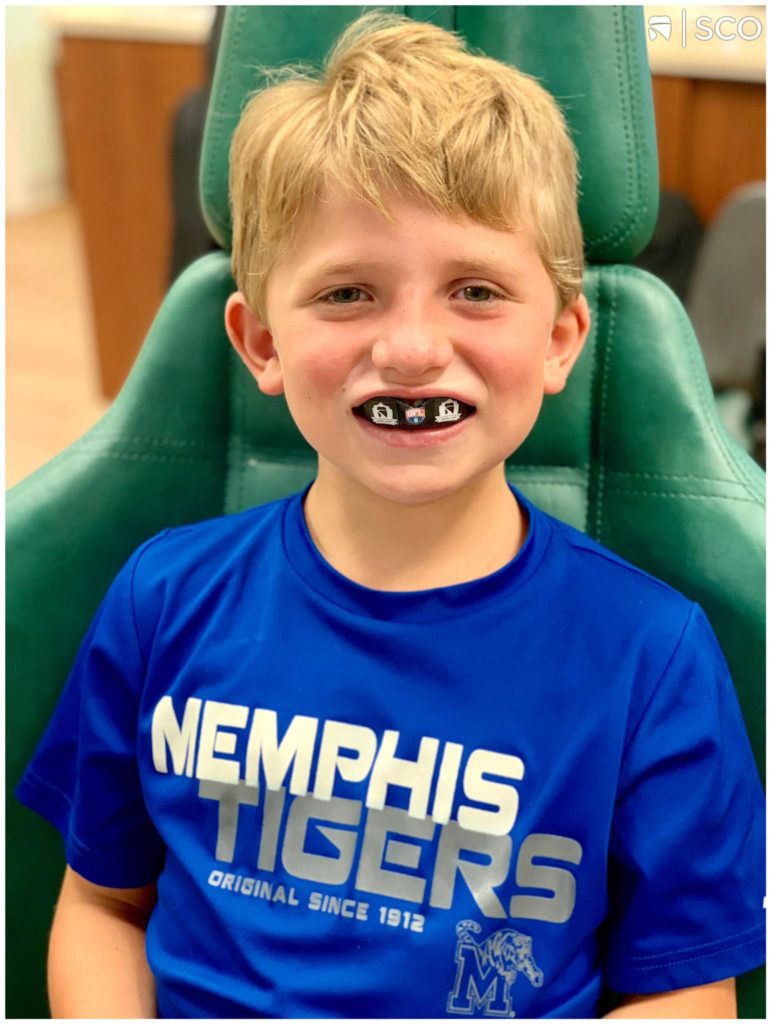If you play sports for your school, community, or church, the upcoming season may feature several unknowns. This is especially true if you’ve had braces put on recently! Even if you’re not sure how things will look in a month or two, it’s always good to know how to keep your braces and mouth safe when participating in physical activities with the help of mouthguards.
Here at Saddle Creek Orthodontics, we treat quite a few athletes, and one of the biggest concerns they tend to have in the beginning is whether or not braces will keep them on the sidelines. Fortunately, straightening your smile doesn’t have to mean missing out on all the action! Keep reading below to learn everything you need to know about protecting your smile with mouthguards.
What are mouthguards? Why are they important for braces patients?
Mouthguards are the easiest way to protect your mouth, whether you’re wearing braces or not. But as an orthodontic patient, it’s extra important to wear one any time you’re playing sports. Because the brackets are attached directly to your teeth, the soft tissues in your mouth are more susceptible to damage if you take a hit to your face. This can lead to cuts, abrasions, and chipped or broken teeth. We recommend mouthguards for low-impact and no-contact sports, as well as those that are high-impact. It only takes a small amount of pressure to cause injury to your mouth or damage to your braces.
Mouthguards are made from a durable plastic that creates a solid barrier between your braces and your gums, protecting the brackets, wire, and your smile all at the same time! You can find them in both regular and orthodontic styles. While regular mouthguards do provide you with a decent amount of protection, the thermoplastic material they’re made of can be an issue for patients who wear braces. When it heats up in your mouth, the mouthguard molds to your teeth and brackets. Because this molding doesn’t move with your teeth as they shift throughout treatment, it can eventually end up working against the straightening process itself.
Orthodontic mouthguards are generally a better option for patients who wear braces and play sports. They’re designed specifically with orthodontic patients in mind, and use a high-grade silicone material instead of thermoplastic. This not only prevents problematic molding, but it also helps cushion your lips and keeps them from bumping up against your teeth and braces. Since orthodontic mouthguards are designed to fit over braces, they do tend to be a little bulkier than regular mouthguards. Don’t worry—they’re still comfortable to wear throughout practices or games.
Choosing the best mouthguard for you
There are three basic questions you should ask yourself when deciding on a mouthguard.
- Does it feel comfortable in your mouth?
- Is the mouthguard too bulky?
- How much room does the mouthguard allow for your teeth to move during treatment?
If your mouthguard is bulky enough that it’s distracting, or doesn’t feel comfortable when you’re wearing it, you’re not going to want to keep it in. Over-the-counter mouthguards that are available online and in many sporting goods stores offer protection for your smile, but do have a more generic fit. That means they may not fit over your braces and teeth as comfortably as they could if they were designed for your unique needs.
Fortunately, we offer customized orthodontic mouthguards. These are created using a mold from your own mouth, which makes them the safest and most effective protection for active braces patients. Customized mouthguards are made with your specific needs in mind to ensure a perfect fit that will last even as your teeth begin to shift towards their new positions, allowing you to wear them for a longer period of time.
That said, the protection provided by over-the-counter orthodontic mouthguards is usually more than adequate for any athlete! The models made by popular brands like Shock Doctor and Tapout are also designed to accommodate the movements your teeth make during treatment. They allow re-molding up to a certain point and will adjust based on your current bite, so they’re also a good choice for active patients wearing braces.
What if you do sustain an oral injury while playing sports?
You can still injure your mouth or damage your braces even if you’re wearing a mouthguard. If this happens to you, you should get in touch with your general dentist as soon as possible so they can diagnose any root or jaw bone fractures. Once you’ve been assessed for damage by your dentist, give us a call and let us know so Dr. Fagala can determine if any part of your braces is likely to need repair.

Keep your smile safe with expert care from Saddle Creek Orthodontics
As you can see, mouthguards are an excellent option for braces patients, whether you’re on the court, the field, or anywhere in between! They shield your teeth as they shift, and help protect the actual orthodontic process, too. While we do find customized orthodontic mouthguards to be optimal, any mouthguard is better than not wearing one at all when you’re an athlete.
Whether you’re a new braces patient or will be having them put on soon, you may be feeling a bit anxious about what’s ahead, especially if you aren’t familiar with the orthodontic process. It’s common to be nervous, but the good news is, our team is super supportive and committed to helping you continue doing the things you love while you’re in braces. That includes playing sports! It’s our goal to give you a positive and stress-free experience, from your first visit with us to your last.
If you have any questions or concerns about how to safely play sports while you’re straightening your teeth, we encourage you to get in touch with us anytime. We can’t wait to see your smile from the stands again!
Best,





